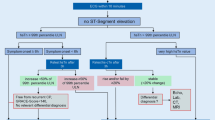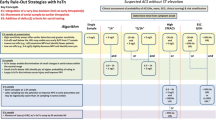Abstract
The reliability of initial high-sensitivity cardiac troponin T (hs-cTnT) under limit-of-detection in ruling-out short- and long-term acute coronary events in subjects for suspected non-ST-segment elevation acute coronary syndrome (NSTE-ACS) is not definitely settled. In a retrospective chart review analysis, 1001 subjects with hs-cTnT ≤ 14 ng/L out of 4053 subjects with hs-cTnT measured at Emergency Department (ED) presentation were recruited. The main outcome measure is fatal or non-fatal myocardial infarction (MI) within 30 days; secondary outcomes are MI or major acute coronary events (MACE) as a combination of MI or re-hospitalization for unstable angina within 1 year. In subjects with hs-cTnT < 5 ng/L [32.6% of cases, mean age 63 years (interquartile range 23)], no cases (0%, NPV 100%) had MI within 30 days, 2 cases (0.6%, NPV 99.4%) MI at 1-year, and 11 cases (3.4%, NPV 96.6%) MACE at 1-year. Patients with hs-cTnT < 5 ng/L would have benefited from a shortened decision (9.30 h and 53% overnight ED stay saved). Hs-cTnT < 5 ng/L is confirmed as safe for patients and comfortable for physicians in ruling out MI or MACE both at short and long term, suggesting that a sizable number of patients can be rapidly discharged without unnecessary diagnostic tests and ED observation.


Similar content being viewed by others
References
Roffi M, Patrono C, Collet JP, Mueller C, Valgimigli M, Andreotti F et al (2016) 2015 ESC Guidelines for the management of acute coronary syndromes in patients presenting without persistent ST-segment elevation: task force for the management of acute coronary syndromes in patients presenting without persistent ST-segment elevation of the European Society of Cardiology (ESC). Eur Heart J 37:267–315
Body R, Carley S, McDowell G, Jaffe AS, France M, Cruickshank K et al (2011) Rapid exclusion of acute myocardial infarction in patients with undetectable troponin using a high-sensitivity assay. J Am Coll Cardiol 58:1332–1339
Reichlin T, Hochholzer W, Stelzig C, Laule K, Freidank H, Morgenthaler NG et al (2009) Incremental value of copeptin for rapid rule out of acute myocardial infarction. J Am Coll Cardiol 54:60–68
Reichlin T, Hochholzer W, Bassetti S, Steuer S, Stelzig C, Hartwiger S et al (2009) Early diagnosis of myocardial infarction with sensitive cardiac troponin assays. N Engl J Med 361:858–867
Than M, Cullen L, Aldous S, Parsonage WA, Reid CM, Greenslade J et al (2012) 2-Hour accelerated diagnostic protocol to assess patients with chest pain symptoms using contemporary troponins as the only biomarker: the ADAPT trial. J Am Coll Cardiol 59:2091–2098
Goodacre SW, Bradburn M, Cross E, Collinson P, Gray A, Hall AS et al (2011) The randomised assessment of treatment using panel assay of cardiac markers (RATPAC) trial: a randomised controlled trial of point-of-care cardiac markers in the emergency department. Heart 97:190–196
Munro AR, Jerram T, Morton T, Hamilton S (2015) Use of an accelerated diagnostic pathway allows rapid and safe discharge of 70% of chest pain patients from the emergency department. N Z Med J 128:62–71
Sebbane M, Lefebvre S, Kuster N, Jreige R, Jacques E, Badiou S et al (2013) Early rule out of acute myocardial infarction in ED patients: value of combined high-sensitivity cardiac troponin T and ultrasensitive copeptin assays at admission. Am J Emerg Med 31:1302–1308
Biener M, Mueller M, Vafaie M, Katus HA, Giannitsis E (2015) Impact of leading presenting symptoms on the diagnostic performance of high-sensitivity cardiac troponin T and on outcomes in patients with suspected acute coronary syndrome. Clin Chem 61:744–751
Freund Y, Chenevier-Gobeaux C, Bonnet P, Claessens YE, Allo JC, Doumenc B et al (2011) High-sensitivity versus conventional troponin in the emergency department for the diagnosis of acute myocardial infarction. Crit Care 15:R147
Ter Avest E, Visser A, Reitsma B, Breedveld R, Wolthuis A (2016) Point-of-care troponin T is inferior to high-sensitivity troponin T for ruling out acute myocardial infarction in the emergency department. Eur J Emerg Med 23:95–101
Mokhtari A, Lindahl B, Smith JG, Holzmann MJ, Khoshnood A, Ekelund U (2016) Diagnostic accuracy of high-sensitivity cardiac troponin T at presentation combined with history and ECG for ruling out major adverse cardiac events. Ann Emerg Med 68(649–658):e643
Body R, Mueller C, Giannitsis E, Christ M, Ordonez-Llanos J, de Filippi CR et al (2016) The use of very low concentrations of high-sensitivity troponin t to rule out acute myocardial infarction using a single blood test. Acad Emerg Med 23:1004–1013
Bandstein N, Ljung R, Johansson M, Holzmann MJ (2014) Undetectable high-sensitivity cardiac troponin T level in the emergency department and risk of myocardial infarction. J Am Coll Cardiol 63:2569–2578
Chapman AR, Anand A, Boeddinghaus J, Ferry AV, Sandeman D, Adamson PD et al (2017) Comparison of the efficacy and safety of early rule-out pathways for acute myocardial infarction. Circulation 135:1586–1596
Granger CB, Goldberg RJ, Dabbous O, Pieper KS, Eagle KA, Cannon CP et al (2003) Predictors of hospital mortality in the global registry of acute coronary events. Arch Intern Med 163:2345–2353
Thygesen K, Alpert JS, Jaffe AS, Simoons ML, Chaitman BR, White HD et al (2012) Third universal definition of myocardial infarction. J Am Coll Cardiol 60:1581–1598
Giannitsis E, Kurz K, Hallermayer K, Jarausch J, Jaffe AS, Katus HA (2010) Analytical validation of a high-sensitivity cardiac troponin T assay. Clin Chem 56:254–261
Earley A, Miskulin D, Lamb EJ, Levey AS, Uhlig K (2012) Estimating equations for glomerular filtration rate in the era of creatinine standardization: a systematic review. Ann Intern Med 156:785–795 (W-270–W-278)
Thygesen K, Mair J, Giannitsis E, Mueller C, Lindahl B, Blankenberg S et al (2012) How to use high-sensitivity cardiac troponins in acute cardiac care. Eur Heart J 33:2252–2257
Sanchis J, Garcia-Blas S, Carratala A, Valero E, Mollar A, Minana G et al (2016) Clinical evaluation versus undetectable high-sensitivity troponin for assessment of patients with acute chest pain. Am J Cardiol 118:1631–1635
Shah AS, Anand A, Sandoval Y, Lee KK, Smith SW, Adamson PD et al (2015) High-sensitivity cardiac troponin I at presentation in patients with suspected acute coronary syndrome: a cohort study. Lancet 386:2481–2488
Body R, Burrows G, Carley S, Cullen L, Than M, Jaffe AS et al (2015) High-sensitivity cardiac troponin t concentrations below the limit of detection to exclude acute myocardial infarction: a prospective evaluation. Clin Chem 61:983–989
Love SA, Sandoval Y, Smith SW, Nicholson J, Cao J, Ler R et al (2016) Incidence of undetectable, measurable, and increased cardiac troponin I concentrations above the 99th percentile using a high-sensitivity vs a contemporary assay in patients presenting to the emergency Department. Clin Chem 62:1115–1119
Chenevier-Gobeaux C, Lefevre G, Bonnefoy-Cudraz E, Charpentier S, Dehoux M, Meune C et al (2016) Why a new algorithm using high-sensitivity cardiac troponins for the rapid rule-out of NSTEMI is not adapted to routine practice. Clin Chem Lab Med 54:e279–e280
Than M, Herbert M, Flaws D, Cullen L, Hess E, Hollander JE et al (2013) What is an acceptable risk of major adverse cardiac event in chest pain patients soon after discharge from the Emergency Department?: a clinical survey. Int J Cardiol 166:752–754
Carlton E, Greenslade J, Cullen L, Body R, Than M, Pickering JW et al (2016) Evaluation of high-sensitivity cardiac troponin I levels in patients with suspected acute coronary syndrome. JAMA Cardiol 1:405–412
Pickering JW, Greenslade JH, Cullen L, Flaws D, Parsonage W, Aldous S et al (2016) Assessment of the European Society of Cardiology 0-Hour/1-hour algorithm to rule-out and rule-in acute myocardial infarction. Circulation 134:1532–1541
Than M, Aldous S, Lord SJ, Goodacre S, Frampton CM, Troughton R et al (2014) A 2-hour diagnostic protocol for possible cardiac chest pain in the emergency department: a randomized clinical trial. JAMA Intern Med 174:51–58
McRae AD, Innes G, Graham M, Lang E, Andruchow JE, Ji Y et al (2017) Undetectable concentrations of a food and drug administration-approved high-sensitivity cardiac troponin T assay to rule out acute myocardial infarction at emergency department arrival. Acad Emerg Med 24:1267–1277
Julicher P, Greenslade JH, Parsonage WA, Cullen L (2017) The organisational value of diagnostic strategies using high-sensitivity troponin for patients with possible acute coronary syndromes: a trial-based cost-effectiveness analysis. BMJ Open 7:e013653
Mueller C, Giannitsis E, Christ M, Ordonez-Llanos J, deFilippi C, McCord J et al (2016) Multicenter evaluation of a 0-hour/1-hour algorithm in the diagnosis of myocardial infarction with high-sensitivity cardiac troponin T. Ann Emerg Med 68(76–87):e74
MacGougan CK, Christenson JM, Innes GD, Raboud J (2001) Emergency physicians’ attitudes toward a clinical prediction rule for the identification and early discharge of low risk patients with chest discomfort. CJEM 3:89–94
Mausner JSKS, Bahn AK (1985) Epidemiology: an introductory text, 6th edn. American Public Health Association, Philadelphia
Acknowledgements
We are grateful to Daniela Bellavista, Medical Project Manager, Roche Diagnostics Italy for helpful support.
Author information
Authors and Affiliations
Contributions
AF and MG had full access to all the data in the study and take responsibility for the integrity of the data and the accuracy of the results. All authors were involved in the study concept and design and statistical analyses. MC, BB, AM, SS and BC were responsible for collection, management, analyses and interpretation of the data. AF and MG conducted the statistical analyses and drafted the manuscript. All authors contributed substantially to its revision and agree to be accountable for all the aspects of the work. FO, ASJ and RD supervised the study. AF takes responsibility for the paper as a whole.
Corresponding author
Ethics declarations
Conflict of interest
The authors have no conflicts of interest to disclose.
Statement of human and animal rights
The authors declare that all contents in this study are in accordance with ethical standards of the institutional and national research committee and with the 1964 Helsinki declaration and its later amendments or comparable ethical standards.
Informed consent
This is a retrospective study and for this type of study formal consent is not required.
Rights and permissions
About this article
Cite this article
Fabbri, A., Bachetti, C., Ottani, F. et al. Rapid rule-out of suspected acute coronary syndrome in the Emergency Department by high-sensitivity cardiac troponin T levels at presentation. Intern Emerg Med 14, 403–410 (2019). https://doi.org/10.1007/s11739-018-1996-6
Received:
Accepted:
Published:
Issue Date:
DOI: https://doi.org/10.1007/s11739-018-1996-6




